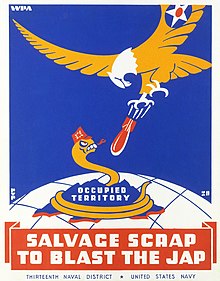
Back الدعاية في الولايات المتحدة Arabic Propaganda in den Vereinigten Staaten German پروپاگاندا در ایالات متحده آمریکا Persian Propagande des États-Unis French تبلیغات په متحده ایالاتو کې Pashto/Pushto Американская пропаганда Russian

In the United States, propaganda is spread by both government and non-government entities. Throughout its history, to the present day, the United States government has issued various forms of propaganda to both domestic and international audiences. The US government has instituted various domestic propaganda bans throughout its history, however, some commentators question the extent to which these bans are respected.[1]
In Manufacturing Consent published in 1988, Edward S. Herman and Noam Chomsky argue that the mass communication media of the U.S. "are effective and powerful ideological institutions that carry out a system-supportive propaganda function, by reliance on market forces, internalized assumptions, and self-censorship, and without overt coercion".[2] Some academics have argued that Americans are more susceptible to propaganda due to the culture of advertising.[3]
- ^ Cite error: The named reference
Politico2was invoked but never defined (see the help page). - ^ Herman, Edward S.; Chomsky, Noam. Manufacturing Consent. New York: Pantheon Books. p. 306.
- ^ Newitz, Annalee (June 4, 2024). "Chapter 3". Stories Are Weapons: Psychological Warfare and the American Mind. W. W. Norton & Company.